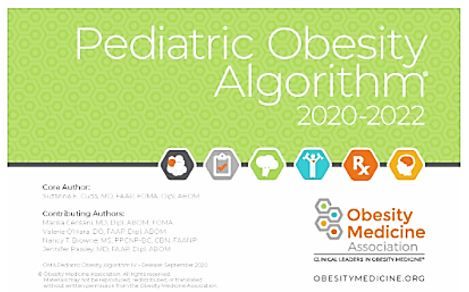- Clinical Technology
- Adult Immunization
- Hepatology
- Pediatric Immunization
- Screening
- Psychiatry
- Allergy
- Women's Health
- Cardiology
- Pediatrics
- Dermatology
- Endocrinology
- Pain Management
- Gastroenterology
- Infectious Disease
- Obesity Medicine
- Rheumatology
- Nephrology
- Neurology
- Pulmonology
To Fight Childhood Obesity, Use the Best Tools Available
Obesity affects nearly 20% of US children, impacting both current and future health. The 2020 update of the Pediatric Obesity Algorithm provides expert treatment guidance.
Childhood obesity has become a significant public health problem in the United States. According to the Centers for Disease Control, 13.7 million children and adolescents in this country are living with obesity. That’s 18.5% of America’s young people at risk of poor health and comorbidities that can impact them for years to come. Combatting this problem requires clinicians and other healthcare professionals to equip ourselves with the right tools and most up-to-date information.

With that in mind, the Obesity Medicine Association (OMA), created the Pediatric Obesity Algorithm®, a set of guidelines to be used as a clinical tool that can support informed decisions when treating obesity in children. First launched in 2016, the Pediatric Obesity Algorithm has been updated every 2 years to ensure it remains an accurate resource. This year, OMA released the third iteration of the algorithm, the most comprehensive and dynamic version to date.
Developed by practicing pediatricians and clinicians who specialize in treating obesity in infants, children, and adolescents, the Pediatric Obesity Algorithm unifies today’s leading scientific evidence, medical literature, and clinical experience in a single resource to help clinicians implement evidence-based practices, make treatment recommendations, and provide referrals to childhood obesity specialists.
What’s new in 2020?
The updated algorithm expands on many sections, but it also incorporates new, important subjects to provide greater depth and value to clinicians. As a pediatrician who sees the unique challenges presented by childhood obesity almost every day, I am particularly pleased that this round of updates includes a critical set of resources for special populations. Every obesity case is unique, so when treating children with Down syndrome, Turner syndrome, and achondroplasia, having resources specific to those populations is invaluable.
The update also introduces information on advanced treatment methods including bariatric surgery, pharmacology, disease management, and device therapy, as well as overviews of nutritional diets such as ketogenic, intermittent fasting, time-restricted eating, and plant-based approaches.
Expanded and revised sections of the tool also include the latest insights on epigenetics, comorbidities (including type 2 diabetes [T2D]), overhauled genetics syndrome and diet recommendations for specific complications, such as T2D and metabolic challenges.
Updating the Pediatric Obesity Algorithm
We would love to include all the new information we find on combating childhood obesity, but our goal is to create a digestible tool with only the most valuable and up-to-date information. To ensure this, with each new iteration of the tool, the authors review and assess all information made available since the release of the previous version. Likewise, all the material included in the previous iterations of the algorithm is re-evaluated for relevance and usefulness. This process can take 6 to 9 months but getting the best version of this all-important tool is worth it.
The co-authors for the third iteration of the Pediatric Obesity Algorithm are all well-respected and practicing pediatricians or pediatric nurse practitioners.* While designed with pediatricians in mind, this tool should also prove useful for family practitioners, internists, and other clinicians who may need to make a recommendation or referral.
How to put the Pediatric Obesity Algorithm to work
Our aim is to continue to demystify the factors underlying treatment of obesity in children that differ from treatment for adults. Obesity treatment is always complex and highly individualized, but with children, there is a lot more to consider, including different treatment goals and approaches at different ages. Our purpose in creating and revising the Pediatric Obesity Algorithm is to make that task more manageable by bringing evidence-based best practices to practitioners, no matter what role they ultimately play in the child’s treatment for obesity.
Ease of use is one of the most important goals for the finished version of the algorithm. To that end, the tool collects the most comprehensive and vetted sources of information possible and is organized by topic. With this tool as a reference, clinicians can be confident about their recommendations and referrals and gain a broad, yet digestible understanding of the many ways obesity manifests in and affects children of all ages, genders, races, and socioeconomic backgrounds. Overcoming childhood obesity is a daunting task, but OMA hopes to support all clinicians who see these patients with up-to-date tools and our organization’s commitment to better outcomes.
To access the Pediatric Obesity Algorithm or to become an OMA member, visit: www.obesitymedicine.org.
Suzanne Cuda, MD, FOMA, FAAP, member TOS, member POWER, is board certified in Pediatrics, Adolescent Medicine, and Obesity Medicine. Following her career in the US Army, she has been practicing Pediatric Weight Management for the past 10 years. She currently runs her own multicomponent clinic, Alamo City Healthy Kids & Families in San Antonio, Texas. Dr Cuda is a Fellow of the Obesity Medicine Association and has participated as an OMA committee member on 3 committees. She is the former Secretary/Treasurer for the Obesity Treatment Foundation. She has lectured in the Review course and the plenary sessions of the Summit multiple times. Dr Cuda has ongoing research on metabolic health and cardiorespiratory fitness.
*It was a great pleasure to work alongside Marissa Censani, MD, Dipl. ABOM, FOMA; Nancy Browne, MS, PPCNP-BC, CBN, FAANP; Valarie O’Hara, DO, FAAP, Dipl. ABOM; and Jennifer Paisley, MD, FAAP, Dipl. ABOM to bring this significant update to others in the field.
